Jennifer Hallock's Blog: Sugar Sun Series Extras, page 6
April 14, 2019
Sugar Moon is here!
The papers back home call Ben Potter a hero of the Philippine-American War, but he knows the truth. When his estranged brother-in-law offers him work slashing sugarcane, Ben seizes the opportunity to atone—one acre at a time. At the hacienda Ben meets schoolteacher Allegra Alazas. While Allegra bristles at her family’s traditional expectations, the one man who appreciates her intelligence and independence seems to be the very worst marriage prospect on the island.
Neither Ben nor Allegra fit easily in their separate worlds, so together they must build one of their own. But when Ben’s wartime past crashes down upon them, it threatens to break their elusive peace.
Find it at Amazon now in both Kindle and print editions.

Excerpt
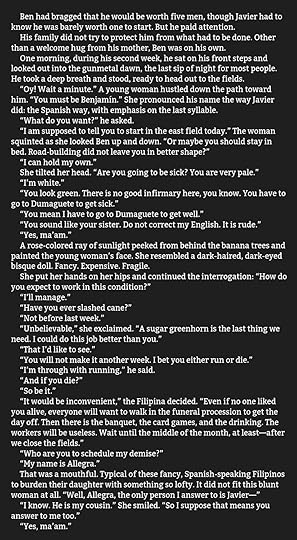
Pick up The second novel in the Sugar Sun series today!
March 31, 2019
A Sewing Hero
Ben Potter is not your typical hero. I don’t say this because of his checkered past, which he has. No, I mean his unusual talent for a male lead in a historical romance: Ben sews.
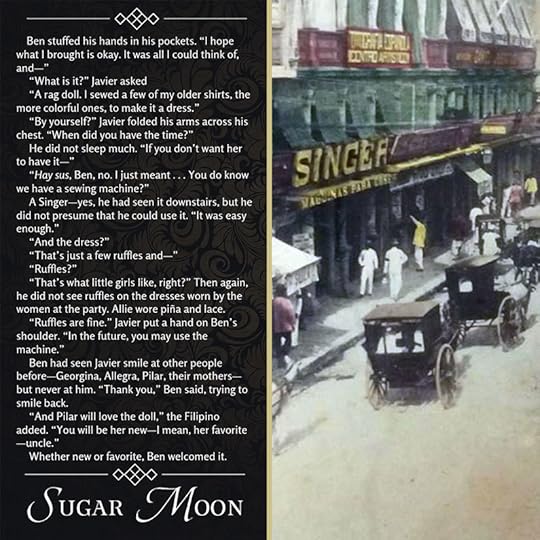
Ben is the grandson of a self-made tailor and the son of an industrious seamstress. He grew up working in his family’s shop. He was supposed to inherit it—before the Spanish-American War broke out, that is. (Before Ben, like so many other young men, were persuaded by the sensationalist press to “liberate” the Cuban people from Spanish tyranny. That’s not how it turned out, by the way.)
Ben has opinions about the fit of suits. He sizes a man up by his “well-molded shoulders” and “perfect trouser break.” He is the one who visits the tailor several times to make his suit fit. “Even so, the collar did not feel right,” he thinks to himself, and after that he makes his own work shirts. Fashioning a doll for his niece is no sweat, and a sewing machine makes dresses for the doll even easier and faster.
Could there really be a Singer on a hacienda in Bais? Yes! The Singer Sewing Machine company had actually been selling their products in the Philippines since 1882, predating the American colonial period. According to Pinoy Kollektor, over a quarter-million units were sold by 300 Singer outlets in the Philippines by 1912, adding 1500 jobs to the economy.
 An early trade card of the No. 66-1 by Singer, as featured on the Pinoy Kollektor website.
An early trade card of the No. 66-1 by Singer, as featured on the Pinoy Kollektor website.The Singer showroom on the Escolta was one of the most photographed landmarks on the street, probably because the Americans who saw it assumed it arrived with Dewey’s navy. (Of course they did.)
 Photo of the Escolta from University of Michigan Philippine Photographs Digital Archive.
Photo of the Escolta from University of Michigan Philippine Photographs Digital Archive.Ironically, one of the reasons that Americans desired an empire was to sell their goods in Asia—particularly in China, but in the Philippines too. Did they need military conquest to do so? No. As Private First Class Reginald “Malik” Edwards, a Vietnam vet, said of that subsequent war, “Sometimes I think we would have done a lot better to by getting [the Vietnamese] hooked on our life-style than by trying to do it with guns….Blue jeans works better than bombs.” In this case, Singer sewing machines would have worked better than Colts and Krags. Ben certainly would have preferred them.
Final note: for more beautiful, historic Singer photographs, check out the website of Pinoy Kollektor.
March 5, 2019
Why you should register for #NECRWA19
 Sharing a table with friends Teresa Noelle Roberts and Kristen Strassel at NECRWA16.
Sharing a table with friends Teresa Noelle Roberts and Kristen Strassel at NECRWA16.NECRWA 2013 in Burlington, Massachusetts, was the first romance writing conference I ever attended, and I will not lie: it was scary at first. I really did not have any friends yet, I was new to the industry, and I had to learn some difficult truths—primarily that the Big Five were not interested in historical romance set in the Gilded Age Philippines. At all. No matter how much they liked my writing, either, as one agent and one editor told me after marking up my pages. Would I be interested in writing a Regency duke for them?
(They were accurately representing the dominant historical chronotope in bestselling romance. I am not defending it, but I have come to grips with the fact that my heartfelt debut story of Georgina and Javier will never be sold in Walmart.)
And yet I have come to realize that meeting with an editor or agent is a great way to get a pulse on the market. I no longer pin my hopes and dreams on traditional publication, and yet I still take advantage of traditional A&E appointments. I put together genuine pitches for what I hope to work on next, and I get ten minutes of helpful feedback. If the agent or editor wants to see a partial or full, I absolutely follow through to see where it goes. Take your ten minutes! And check out who’s coming this year:
(For total transparency’s sake: I am the 2019 Agent and Editor chair of the conference. You’ve been warned.)
But back to my 2013 story: do you know who got me through my initial tearful disappointment? The wonderful friends I made at #NECRWA13! Many of them had never met me before that day, but they sat with me and helped to soften the blow when the very real anvil of publishing flattened me on the pavement. In my six years of conference going, my conclusion has not changed: NECRWA is one of the friendliest regional conferences around.
NECRWA has also become more inclusive, especially in the last three years—whether inclusion means indie versus trad writers, smaller subgenres, or diverse fiction and specifically #ownvoices. Check out the workshops below:
Finally, we have a banging book event. It’s called the T.G.I.For Literacy Book Signing, and for the low, low price of $20 per author, half of which goes to a literacy charity, you can join too! It is free to the public, and there is no book fair with a longer table of gift baskets. At least, I don’t think so. I was the emcee for this event last year, and I think we had over 60. Sixty baskets. That’s a lot of free books.

Are you sold yet? You should be! Please come join us next month. Find the registration links on the NECRWA homepage. And come introduce yourself to me in person—I’ll be one of the conference committee wearing a tiara. (Haha, if you know me, you know how funny that is. I coach American football FFS.)
February 4, 2019
Upcoming Workshops: Spring/Summer 2019
I am so pleased to be offering a smattering of workshops all over the East Coast this year. Here they are, with descriptions:
First, I will be reprising my study of historical romance at the New England Chapter of Romance Writers of America on May 19, 2019:
Over eighty percent of bestselling historical romance books published in the first half of 2018 were set in Britain, either during the 19th century or the medieval period. These two fabricated chronotopes are selectively accurate to history and narrowly focused on high ranks of the nobility—in other words, they are “escapism.” This presentation will consider what escapism means in this context, who it serves, and who it harms. While any reader can enjoy a good duke Regency every once in a while, the net impact of the most popular chronotopes may be to corrode our understanding of history, marginalize anyone writing from a wider palette of settings and characters, and exclude authors of color.
I originally gave this talk at IASPR 2018 in Sydney, Australia. I will expand my comments a bit because I have more time, and I will answer any questions the NECRWA folks have. Guests are welcome (for a nominal $5 fee to the chapter).
My other speaking engagements this summer will be more focused on history itself and historical research:

On Friday, June 21, 2019, bright and early at 8am (!), I will be presenting at the Historical Novel Society North America conference. My talk is entitled, “Schoolbenches and Trenches: The Philippine-American War Setting”:
Liberate and uplift? Or conquer and oppress? The revolutionaries of the eighteenth century became the redcoats of the twentieth, fighting a war to seize the Philippines (1899-1913) as the first step toward overseas empire. Enter the American Century, complete with debates over transpacific trade, immigration, Muslim separatists, and national security—all issues that resonate for the modern reader. Historian, teacher, and author Jennifer Hallock will explain why the U.S. colonized the Philippines, how this experience still shapes both countries now, and how it creates engaging American historical fiction.
I have given this talk to libraries and school groups in both the United States and the Philippines. Here’s an interesting twist: my Manila audience knew they had been an American colony—putting them ahead of far too many Americans!—but they had not been taught about the Philippine-American War itself or many of the controversial policies the Americans used to pacify the islands. If you want to know more, check out my history posts on this website.
Finally, I will be a part of two workshops at the Romance Writers of America national conference in New York City, this 24-27 July 2019. In addition to being invited to take part in a Gilded Age panel (more on this to come!), I will be giving my own researching workshop:
How do you write authentic characters who are nothing like you? Through lots of research, of course. But beware—flat descriptions from encyclopedias won’t cut it because they reflect only the most common experience. The best characters are the outliers: the unusual, precocious, and maybe even dangerous heroes and heroines. Learn how to find inspiration from free sources online, such as books, memoirs, documents, newspapers, magazines, advertisements, maps, photographs, clothing, artifacts, personal papers, and videos. Though this workshop’s emphasis will be on historical research, especially the 18th through early 20th centuries, it will include tips and tricks for all authors. Just like the Hunger Games series used allusions from ancient Greece to Vietnam, true stories inspire the best fiction, no matter what genre.
I hope to see you this year at one of these conferences or workshops. If you would like me to bring one of these closer to you, please contact me at jen at jennifer hallock dot com. And happy writing!

January 14, 2019
Essential History for Sugar Moon
I began writing Sugar Moon in 2013. I began writing this blog in 2016. In both cases, that’s a long time ago. It includes years of writing about the Philippine-American War, and in particular the Balangiga incident—a central event shaping the character of my redemption-seeking-hero Ben Potter.
Let’s say you know nothing about what happened in Balangiga—or even nothing about the Philippine-American War. Don’t worry, you won’t need to in order to read Sugar Moon. But let’s say you’re a history geek like me? Well, I’ve written a lot of content just for you!
I have tried to organize this by the most logical questions. Read the captions, and if you want to know more just click on the link below the image. Geek out!
Question 1: Where is this book set?
 Most of the Sugar Sun series takes place in the Visayan Islands in the central and southern Philippines.
Most of the Sugar Sun series takes place in the Visayan Islands in the central and southern Philippines.





Question 2: Why were Americans in the Philippines?
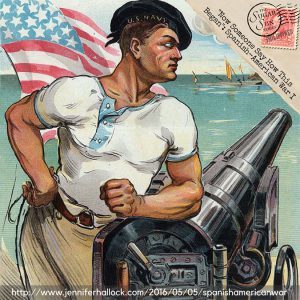
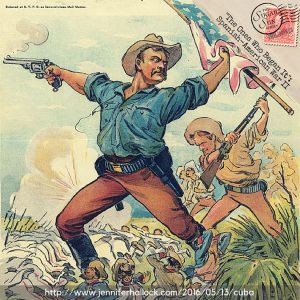
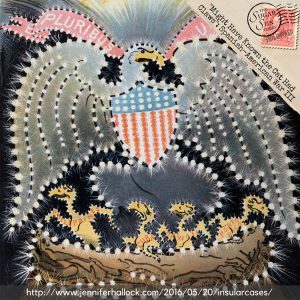
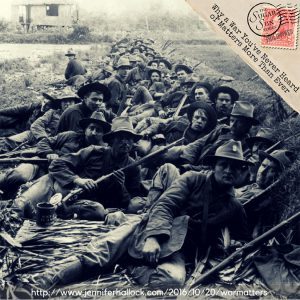
Question 3: What happened in Samar?

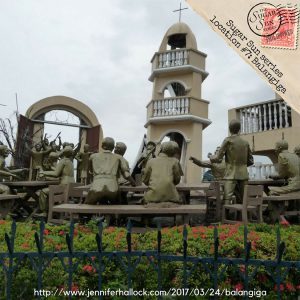
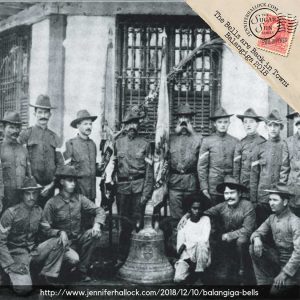
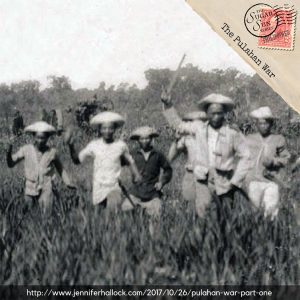
Question 4: What else do I need to know about a soldier’s life in 1901?
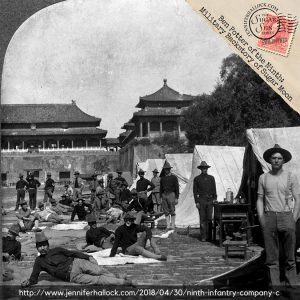
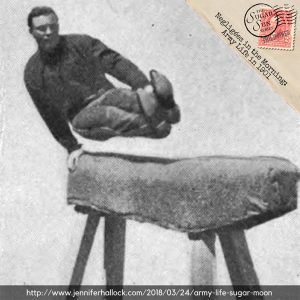
Question 5: What else should I know about the world of Ben Potter?
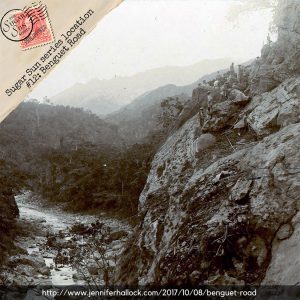
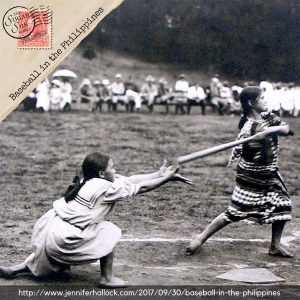
Question 6: What should I know about the world of Allegra Alazas?


And you can find out more about Allegra, her home, her family, and her background by reading through these annotated glossary posts:






Question 7: Where can I find some excerpts from this book?
 Click on this banner to take you to the Sugar Moon teasers.
Click on this banner to take you to the Sugar Moon teasers.Question 8: When will Sugar MOon be published?
Spring/Summer 2019.
Not good enough for you? All I can say is that I’m working on it. Today wasn’t super productive—hence this page because blogs are great for procrastination. Don’t think I’m doing nothing, though. I’m mulling over a problem in my head, and these things can’t be rushed. And believe me, I’m more anxious about getting this book into the world than you are.
Thanks for reading!

January 1, 2019
Why romance? New Year’s musings
You might think mixing romance and history would be a highly-marketable combination, but there are a few landmines. Fans of historical fiction (who often know little about romance) want you to take out the happily-ever-after to make your book more “realistic” and “serious.” Fortunately for me, Olivia Waite came along and explained the problem with taking away my heroines’ HEAs:
Jeannie Lin added that the Asian women in her family have suffered through “regime change, through executions, through so many personal tragedies—and still found a way to find happiness. That story is just as real.” As I’ve heard Beverly Jenkins say several times at conferences: even in the toughest of times, people still have picnics, birthday parties, and fall in love.
Of course, some of the worst bits are history are not going to make it to the page in a romance. (Hello, syphilis? Around ten percent of the general American population had the disease by 1900, and I choose to entirely ignore that fact.) I have written and discussed in interviews why I chose to set my books in the Philippine-American War. (They are not the typical Regency duke books, for sure.) I used my own scholarship on American colonial rule in the Philippines to fabricate my own fictional chronotope: I choose when to be constrained by real history and when to hold onto a more modern sensibility.
Writers have been fabricated chronotopes in historical fiction for centuries. Antony and Cleopatra—while not a romance—is proof that Shakespeare made this same choice. The play is based partly off the history he had at his disposal, Plutarch’s Lives, but he also added scenes and changed historical facts to suit the story. Some scholars even say that Shakespeare was really writing a political commentary of his times, using Elizabeth I as his model for Cleopatra. While Shakespeare is the platinum standard of literature now, keep in mind that he wrote popular fiction back then. He was a storyteller.
That’s what romance is: good story-telling that makes you feel. Tess Sharpe came up with a pretty exhaustive list of what I mean by this:
But let’s not ignore sexual chemistry. One of the reasons that romance makes a person feel so intensely—and that is a big part of its appeal—is that the reader is so heavily invested in the two main characters and their relationship. How does that happen? How does the reader become so intimately involved? By being present at the most intimate of scenes, when the armor of clothing is shed and the characters become figuratively and literally naked. The sex scenes advance the plot because they are about navigating the relationship in its most raw state.
Now, I will end with an apology. Clearly, it is now 2019, which means this brag did not pan out:

My blend of “history ever after” has been a particular challenge in this book, and so revisions have needed revisions. I feel confident it will be out by spring 2019. Stay tuned!
December 25, 2018
Pizza, puppy, parol, and phunk
Mr. Hallock and I have a tradition we created our first year of marriage: pizza for Christmas. We spent the 1998 holiday in West Beirut, then our home. Since our neighborhood was predominantly Muslim, everything was open! (Also, the Lebanese knew that Santa can sell anything. For example, our local manousheh joint, Faysal’s, dressed an employee in a perfect jolly red suit and handed out chocolates.) Stephen and I were not big chefs or bakers yet (well, I’m still not), so we were hardly going to make a big dinner for two. We did the obvious thing: we ordered a pizza. Not obvious to you? As we sat and scarfed down a great New York-style pepperoni and mushroom pie, we decided we would always have pizza (or something styled after pizza) for Christmas. We have not broken that tradition in 20 years. There is dough resting on the kitchen table as I type…
 A 1960s Christmas postcard from the Philippines, courtesy of the fabulous Pinoy Kollektor website.
A 1960s Christmas postcard from the Philippines, courtesy of the fabulous Pinoy Kollektor website.The holidays have also been about our nuclear family, i.e. our dog(s). We sadly said goodbye to seventeen-year-old Jaya two years ago, and before that to fifteen-year-old Grover. This is our first Christmas with a little pipsqueak called Wile E. Dog. Her auntie and uncle brought her pigs’ ears, so she’s been just fine with the madness of the holidays.
And, yes, we have a parol—adjusted to 110v by our amazing Ate Edith! We give passing traffic seizures, but, hey, it’s festive.
Finally, one of my favorite holiday traditions: good funky Christmas music. My favorite funk? Bootsy Collin’s Christmas is 4 Ever.
One thing you will have to do without this season is Sugar Moon. It is still coming soon, but rewrites are thorough and ongoing. We are hoping for early 2019, certainly in the first half of the year. Until then, check out the teasers on this site. If you want something Christmas-y, also please check out the epilogue of my latest novella, Tempting Hymn. (Click on the image for a buy link.) Merry, merry.
December 10, 2018
The Balangiga Bells are Repatriated
The bells of Balangiga are scheduled to land right now in Manila. A US Air Force plane will finally deliver them back to the country they were taken from 117 years earlier. Why would the US give the bells back now, at a time when relations between the two countries may be at their worst point since the Philippines ejected Americans from their Luzon military bases in 1992? Why did the American government finally decide to ignore the Wyoming congressional delegation—including the daughter of former Vice President Dick Cheney—who still openly opposes the return of the bells?
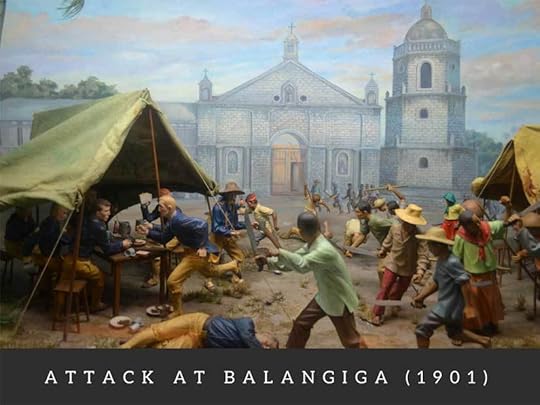 One of many wonderful dioramas designed by the Ayala Museum and now viewable through the Google Cultural Institute.
One of many wonderful dioramas designed by the Ayala Museum and now viewable through the Google Cultural Institute.The joint efforts of veterans and scholars deserve a lot of the credit. Even if they did not convince the Department of Defense to finally take this move—because the Pentagon does what the Pentagon wants, after all—they were essential in greasing the airplane wheels. Only after the Balangiga Research Group, which includes authors Rolando O. Borrinaga and Bob Couttie, assembled a better understanding of the attack could both sides move on.
 Two outstanding scholars on the Balangiga Incident, Rolando O. Borrinaga and Bob Couttie. Bottom right is my photo of the monument to the attackers in Balangiga town.
Two outstanding scholars on the Balangiga Incident, Rolando O. Borrinaga and Bob Couttie. Bottom right is my photo of the monument to the attackers in Balangiga town.But some of the credit also goes to the increasingly worrisome geopolitical struggle between the United States and China—a struggle that the Philippines will literally have a front-row seat for. This is good for none of us, but it helped bring the bells back.
I tried to write something short for this blog and failed. Instead of posting a long article here, please feel free to download my paper and read it at your leisure. Congratulations to the people of Balangiga, Samar, and the Philippines as a whole. This should have happened long ago.
November 25, 2018
Procrastination Station: Vintage Postcards
I have ten more comments to write for the end of the Fall Term, so of course I have been making ads out of vintage postcards from the American-era Philippines. As one does.
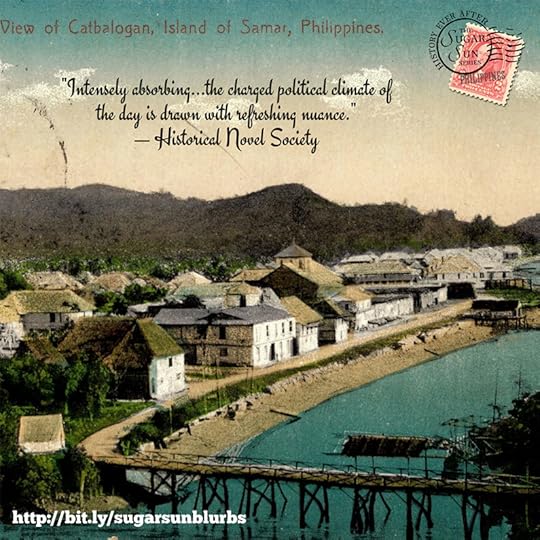




For more on the locations pictured here, please see my illustrated, annotated locations posts. Enjoy!
November 11, 2018
Not your typical Thanksgiving story
How my grandmother ended up at a Cuban cockfight in a fur coat with a man who wasn’t her husband…
I was not born early enough to meet either Dominick or Carmella, my great-grandparents, and that is my loss. Both came to the United States as teenagers. Had they stayed in Italy, though, they might not have been allowed to marry. Carmella’s parents had been relatively well-off in Sicily, while Dominick had little formal education and was forced into the hard life of coal mining in the hills of West Virginia. Moving to the United States was a bit of an equalizer—all immigrants struggle—but Carmella’s family still had their pride. When Dominick proposed marriage, Carmella’s mother demanded that he build his bride a big house in Morgantown. None of their children could explain to me how he got the money to do that, but he did. And, in the day before interstate highways, he even managed to commute to and from the mine so that his wife did not have to live in the hollow.

Dominick worked hard and managed to keep his wife and seven children in their family home throughout the Great Depression. There are two reasons often given for how he accomplished this impressive feat. First, it seems that he was such a consistent and reliable worker that his boss at the mine always made sure to keep him on, despite dramatic layoffs. Second, and more relevant for these times, his mortgage was replaced by a loan from the Home Owners’ Loan Corporation, a New Deal program. In this program, the federal government bought out mortgages from banks (who were happy to exchange it for bonds) and then gave a more favorable, more patient loan to the homeowner. Where was this in 2007, huh?
Not only did Dominick keep his job and his house, but he also made sure that his younger children—male and female—were college-educated at West Virginia University right down the street. Unfortunately, the older children were not so fortunate. For example, Dominick and Carmella’s second child, Josephine, was not able to go to college. This woman, my grandmother, graduated high school square in the middle of the Depression, in 1937. I still wear her class ring. (I guess the fact that she was still able to buy a class ring at this time is something, at least.)
Now, even though Dominick and Carmella married for love, they did not give Josephine the same choice. Her first marriage was arranged, and it failed—spectacularly. Her husband was domineering and abusive. This was my grandfather that I barely knew.
When my mother and her sister were in high school, Jo left her family for the man she had loved since high school. Why hadn’t she married Jess to begin with? Class mattered, once again. Jess’s family ran a profitable grocery store. While Dominick and Carmella were upstanding citizens and homeowners, their daughter was not what Jess’s family had in mind. After being denied this first time, Josephine and Jess ultimately ran away together. Far away. To Cuba. In 1958. The year before the revolution.
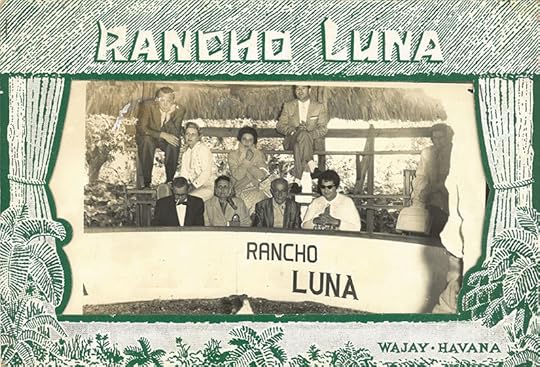
This is my favorite photo of Jo. This photo finds her and Jess watching a cockfight at a resort in Wajay, Havana. Apparently, it was cold because my grandmother is wearing a fur coat. Jess looks typically uptight next to her. They do not have the body language of recently requited lovers, to say the least. (Jess—or “Uncle Jess” as I called him—was never very demonstrative, to say the least, but he was always very kind to me.) They would later marry, divorce, and remarry. Status update: complicated.
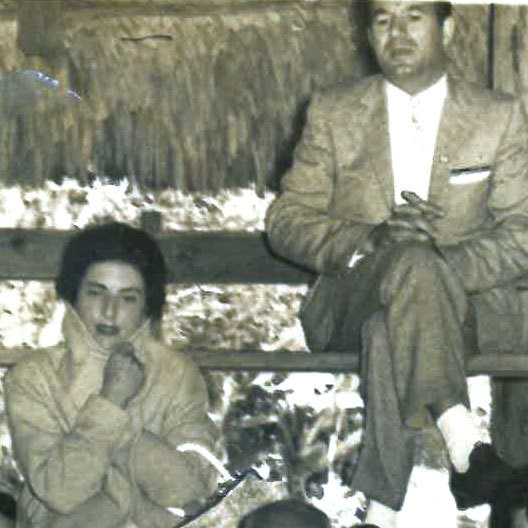
The whole thing is still a sore subject in my family. It caused a lot of pain and embarrassment. It was the fifties, when Josephine’s Catholic family did not find domestic abuse a reason to dissolve a marriage. (They did not believe in divorce, in any case.) Moreover, because my grandmother was in Cuba, my mother and her sister had to change high schools and move in with their father, who quickly remarried. My mother’s relationship with Josephine thawed only when I grew to be about five or six years old. It was Josephine’s more settled and reliable sister, Anita, who planned my mother’s wedding, for example. It was Anita who still filled the role of grandmother for much of my life, until her death this past summer. (Miss you, Ya!)
E ven after Josephine and Jess were invited back to the table, things did not always go smoothly. Jess became a landlord of student apartments in Morgantown, and it was Josephine’s job to scour them. Jo scrubbed floors during the day and slaved over the stove in the evening—hardly a romance. She worked hard, and my mother resented Jess for that, not surprisingly. Uncle Jess was certainly set in his ways by the time I knew him. He was a Pabst Blue Ribbon man—tall boys—and he wanted his beer with dinner. Not before dinner, not after dinner, but just as dinner hit the table. Yet he was Josephine’s choice. I cannot explain it.
I do have good memories of Josephine and Jess, though. They mostly involve obscene amounts of food. Thanksgiving included at least three main course choices—turkey, ham, and maybe even a meat chop of some kind—plus about a thousand side dishes, the best of which were the stuffed artichokes. Jess, the grocer’s son, never trusted any supermarket in Columbus. Every holiday he arrived with a car of overflowing bags from his favorite Italian haunts in Morgantown. On the pepperoni front, I appreciated his snobbery. We had a tradition that he would bring in that bag first for me. It was a good tradition.
Josephine should get the most credit for the food, though. Once my grandmother was staying with me while my parents were away, and my high school boyfriend came over for dinner. She had prepared her signature dish: true Sicilian spaghetti with her own fresh pasta CUT BY HAND. He naively accepted her offer of seconds, which meant that she piled a new plate taller than the first. He looked at me, stunned, like he wanted me to get him out of eating the whole darned thing. I just shrugged at him. You don’t mess with an Italian grandma. Unfortunately, that kind of eating, along with chain smoking and obesity, led to her unfortunate death in 1991. I miss her too.
As we approach Thanksgiving, I wanted to give thanks for the bounty we always enjoyed at Josephine’s table. Her legacy was complicated. Her (and her parents’) choices did not really pay off, at least not for her. But she was not afraid to try, and I admire her for that.

Sugar Sun Series Extras
- Jennifer Hallock's profile
- 38 followers















